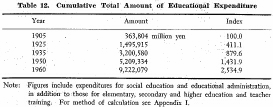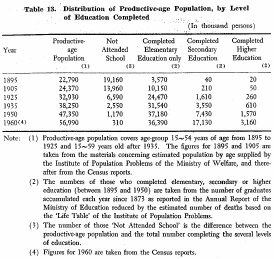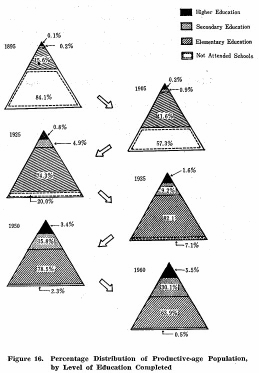| Home > Policy > White Paper, Notice, Announcement > White Paper > JAPAN'S GROWTH AND EDUCATION 1963 > CHAPTER |
||
How much educational expenditure has been spent for the productive-age population of the people? The cumulative total amount of the expenditure for education in Japan in 1905, 1925, 1935, 1950 and 1960 is shown in Table 12.

Cumulative total educational expenditure from 1905 through 1960 represented an increase of nearly 2,430 per cent over the expenditures of 1905. Some measure of the effect of this increase in the financial investment in education is revealed by concomitant changes in the distribution of the population of productive-age according to average level of schooling completed. Such data are presented in Table 13, and obviously bear a high positive correlation t6 the cumulative investment in education.

Cumulative total educational expenditure from 1905 through 1960 represented an increase of nearly 2,430 per cent over the expenditures of 1905. Some measure of the effect of this increase in the financial investment in education is revealed by concomitant changes in the distribution of the population of productive-age according to average level of schooling completed. Such data are presented in Table 13, and obviously bear a high positive correlation t6 the cumulative investment in education.
Increases in the numbers completing secondary and higher education correspond closely with increases in cumulative educational expenditures, while an inverse relationship is shown between increasing cumulative investment in education and numbers not completing even the elementary school level. The expansion of secondary education is evidenced not only in the continuous high rate of increase in total numbers completing secondary education, but also in the declining rates of increase in numbers completing only the elementary schoo1 1evel. The decrease in the 1atter between 1950 and 1960 resulted from implementation of compulsory education through the lower secondary school.
As the productive-age population represents the great bulk of the labor force, increases in the average level of education of this group may be considered as prima facie evidence of improvement in the quality and capability of the labor force. Thus education, by improvement of the human factor, has contributed positively and greatly to the improvement of the socio-economic development of Japan.
We have seen in Chapter I how the qualitative improvement of the human factor as manifested in the improvement of educational background of the people, has been contributing to the socio-economic development of Japan, especia11y to the increase in her gross national product, by estimating the rate of contribution of cumulative expenditure for education to the increase of national production.
The above examination of the rate of return on the educational investment may lead to a more concrete and detailed analysis when the problems concerning the quality of education at each level, i.e. those concerning the allocation of educational expenditure and the distribution of major fields of study, are taken into consideration.

| Back to Top | MEXT HOME |